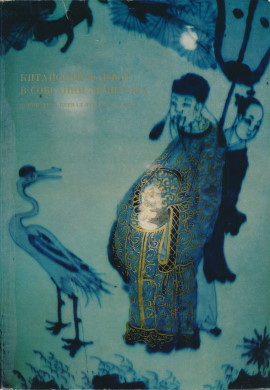 Т.Б. Арапова
Т.Б. Арапова
Китайский фарфор в собрании Эрмитажа.
Конец XIV — первая треть XVIII века. Каталог.
// Л.: «Аврора». 1977. 136 с.
Содержание (в издании нет)
[ Введение. — 5-7 ]
[ Цветные илл. I-XI. — 8-16 ]
Фарфор династии Мин (1368-1644). — 17
Ранняя Мин (1386-1435). — 17
Средняя Мин (1465-1521). — 17
Поздняя Мин (1522-1644). — 18
Фарфор мастерских Лунцюаня. — 20
Фарфор династии Цин (1644-1735). — 22
«Переходный» период (1644-1662). — 22
Период Канси — Юнчжэн (1662-1735). — 23
Фарфор с росписью в гамме «зелёного семейства» (famille verte). — 24
Фарфор с росписью кобальтом. — 25
Фарфор с росписью в технике «blue poudré». — 27
Фарфор с росписью эмалями по бисквиту. — 27
Фарфор с росписью красной краской. — 28
Монохромы. — 28
Примечания. — 30
Каталог / Catalogue. — 33
Фарфор династии Мин (1368-1644) [1-42]. — 35
Фарфор мастерских Лунцюаня [43-64]. — 57
Фарфор династии Цин (1644-1735). — 22
«Переходный» период (1644-1662) [65-71]. — 22
Период Канси (1662-1722) [72-185]. — 71
Период Канси — Юнчжэн (1662-1735) [186-199]. — 125
Таблица марок и надписей. — 133
Литература. — 134
Summary. ^
The catalogue contains information on the Hermitage collection of Chinese’ porcelain of the late 14th — first third of the 18th century, the largest in the Soviet Union. All the material is arranged according to the chronological principle and falls into two parts, Ming porcelain (1368-1644) and early Ch’ing porcelain (1644-1735). Within these parts, the main stages in the evolution of porcelain are traced on the basis of an analysis of the decor and technology employed. The Ming porcelain forms three groups, the early Ming (1368-1435), the middle Ming (1465-1521) and the late Ming (1522-1644); wares from Lung Ch’uan workshops (the so-called celadons) constitute a special group, for these wares, with their traditional ornamentation and shapes, do not lend themselves easily to precise dating and are usually related to the whole time span of the dynasty’s rule.
The early Ch’ing group is classified into wares of the “transition period” (1644-62) and those of Kang Hsi-Yung Chêng’s reign (1662-1735).
The materials of the Hermitage collection provide a sufficiently comprehensive picture of the types of porcelain decor. The Ming wares were characterized by different variants of flower, geometric, bird and animal motifs. Special mention should be made of the genre compositions whose themes reflected the democratization of the Chinese culture during the period (scenes from popular plays and novels or from the life of various social strata of the population). These compositions, moreover, serve to broaden our knowledge of the popular beliefs of the time, revealing as they do the changes in meaning of certain images and the evolution of the iconography of several Tao deities. The painting on Ming porcelain also reflects China’s ties with the countries of the Near East and Central Asia.
Materials of the Hermitage collection give an insight into the process of the formation of the artistic features peculiar to that period, and to it alone. These are the arrangement of decorative motifs in strict correspondence with the object’s structural forms; the compact compositions, built according to certain set types, and the expressive drawing.
Early Ch’ing porcelain displays a preference for a heightened decorativeness achieved by the use of new techniques. This accounts for the emergence of the “green family” colour scheme, of the “bleu poudré” or of enamel painting on biscuit. The themes of the decor also underwent a change. The leading role came to be played by polychrome painting of flowers and birds. As for genre subjects, these, in the main, reflected the life of the affluent groups of the population, for example that of officials. Besides, there were wares decorated with symbolic motifs mainly serving to express good wishes for the owner in his official career. It should be noted that porcelain decoration was the art form in which the earliest versions of these subjects and motifs were recorded.
Not all the objects in the Hermitage collection of Chinese porcelain of the late 14th — first third of the 18th century are of equal artistic value and not all the periods are represented with equal completeness. Nevertheless the numerous items of the collection afford an insight into some important aspects of the evolution of applied art in China, where porcelain was the dominant field, a field which best and most vividly reflected the specific character of the country’s culture of that time.
|